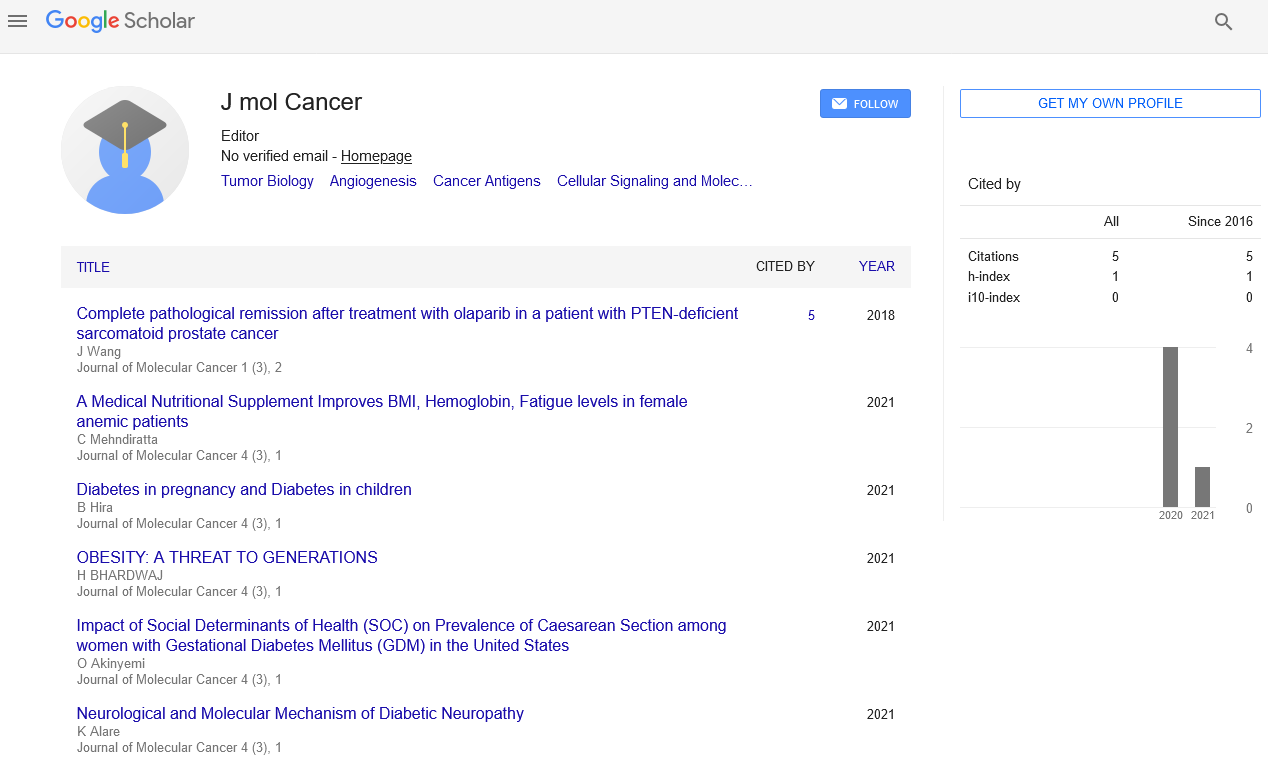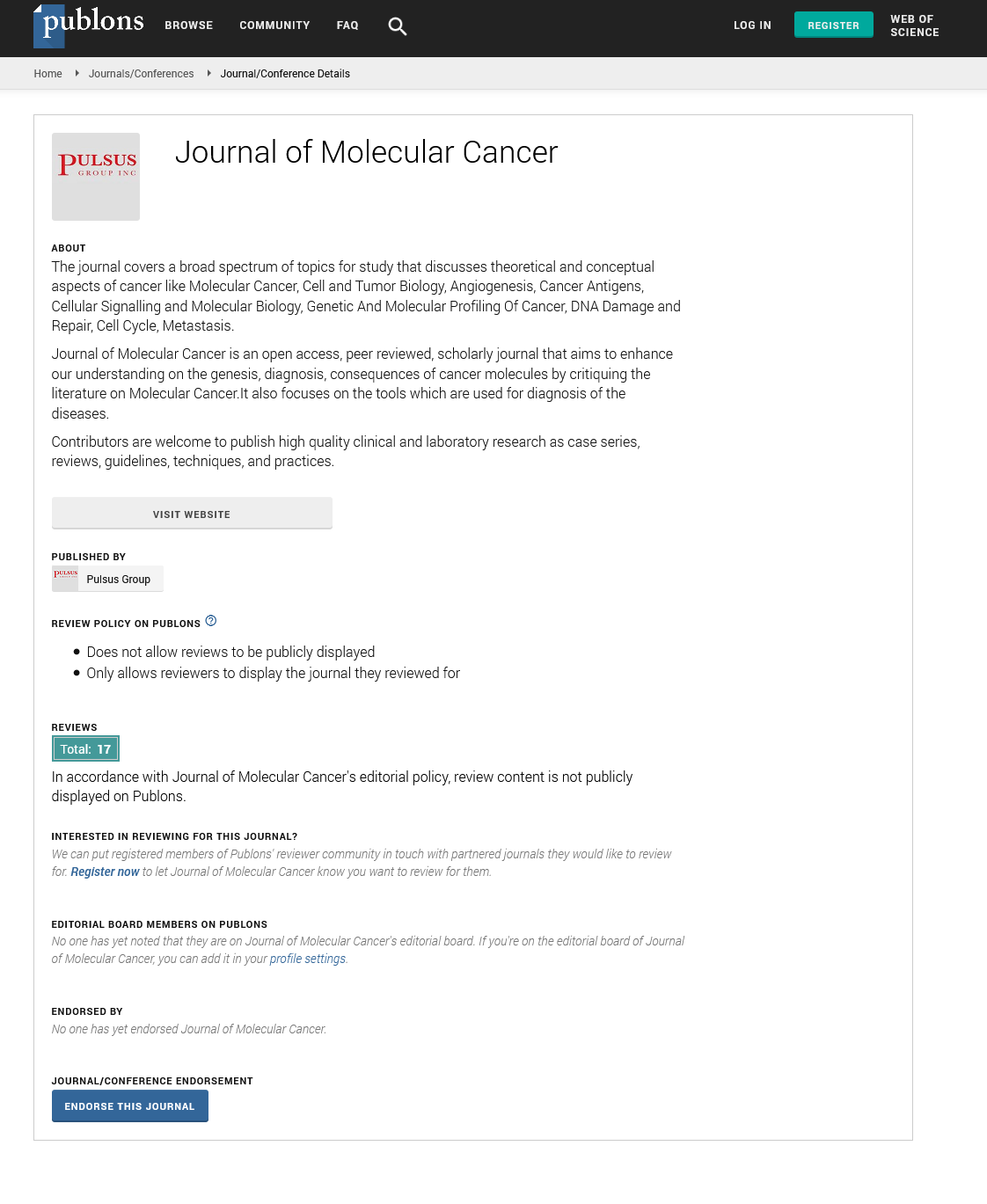Circulating tumor cells
Received: 06-Jan-2022, Manuscript No. PULJMC-22-4210; Editor assigned: 08-Jan-2022, Pre QC No. PULJMC-22-4210(PQ); Accepted Date: Jan 07, 2022; Reviewed: 13-Jan-2022 QC No. PULJMC-22-4210; Revised: 18-Jan-2022, Manuscript No. PULJMC-22-4210(R); Published: 30-Jan-2022, DOI: doi:10.37532/puljmc.22.5.1.1
Citation: Ryujin K. Circulating tumor cells. J Mol Cancer. 2022;5(1):1.
This open-access article is distributed under the terms of the Creative Commons Attribution Non-Commercial License (CC BY-NC) (http://creativecommons.org/licenses/by-nc/4.0/), which permits reuse, distribution and reproduction of the article, provided that the original work is properly cited and the reuse is restricted to noncommercial purposes. For commercial reuse, contact reprints@pulsus.com
Abstract
Circulating tumor cells are metastatic forerunners in a few disease types. Their science and clinical utility are dependent upon various examinations, yet one viewpoint that is regularly dismissed is their entrapment with the growth microenvironment, to be specific the cross talk with stromal and safe cells and their associations with other cancer determined parts like circling cancer DNA and extracellular vesicles available for use. We will zero in our short survey explicitly on these viewpoints, i.e., giving a few instances of the contact that flowing growth cells have with stromal or insusceptible cells and representing their relationship with other coursing cancer subsidiaries like circling cancer DNA and extracellular vesicles.
Key Words
Circling growth cells; ctDNA; miRNAs; T lymphocytes
Introduction
Metastasis actually represents most of malignant growth related passing. Circling Growth Cells (CTCs) are disease cells that have shed from a strong cancer sore and went into the circulatory system, going about as seeds that might possibly spread too far off destinations and cause new metastatic sores. Accordingly, these cells are significant to understanding the underlying foundations of blood-borne metastasis and are thus of extraordinary natural interest. In fringe blood tests, CTCs are incredibly intriguing contrasted with platelets, and, in many patients with cutting edge malignant growth, we can regularly hope to find somewhere in the range of 0 and 10 disease cells for every 10 mL of blood. By the by, it is accepted that CTCs are progressively coordinated, with without a doubt, not many of them having the option to endure the circulatory system, extravasate, and complete the metastatic cycle. CTCs have been distinguished in various epithelial tumors, including bosom, prostate, lung, colon, and pancreatic disease, and furthermore in malignant growths that don’t communicate markers of epithelial beginning, for example, glioblastoma multiforme or melanoma. Significantly, CTCs are by all account not the only malignant growth determined material contained in fluid biopsies-these contain different components like Extracellular Vesicles (EVs), Micro-RNAs (miRNAs), or Circulating Cell-Free Tumor DNA (ctDNA), every one of which can be of clinical pertinence. ctDNA alludes to the small part of without Cell DNA (cfDNA) that is shed into dissemination by cancer cells, hence mirroring the mutational scene of their essential growth. Exosomes are characterized as a subset of EVs of more modest size, ∼30-150 nm, beginning from the endosomal compartment and delivered by reasonable cells into the circulation system through exocytosis. CTCs are ordinarily segregated with antigen-ward or antigen-free advances. The clinical utility of CTCs, ctDNA, and exosomes not exclusively relies upon their intrinsic organic properties yet in addition on the picked technique for examination.
Result
In non-little cell cellular breakdown in the lungs and fiery bosom malignant growth, CTC levels have been found to connect with the level of invulnerable observation, particularly as to specific insusceptible cell types. In particular, the quantity of CTCs was conversely corresponded to CD8-positive fringe T lymphocytes in patients with bosom disease and to CD3-positive, CD4- positive, and CD8-positive fringe T lymphocytes in patients with NSCLC. In any case, the capable organic components of CTC and T lymphocyte cooperation are yet to be completely disentangled. This relationship was likewise found for NK cells in Non-Small Cell Lung Cancer (NSCLC), which isn’t shocking thinking about their cytotoxic impacts on CTCs. Future endeavors will be required in enormous patient associates to decide to which degree the data got from growth inferred parts in fluid biopsies catches cancer heterogeneity yet, above all, to which degree it catches illness movement important growth sub clones. The metastatic spread of disease is a complex, multi-step process that includes an assortment of variables. These elements are trapped with one another and characterize sickness forcefulness yet additionally helpful open doors. Examinations of the Total Mesorectal Excision (TME) have obviously uncovered a conspicuous job for non-neoplastic cells in molding the metastatic course in different disease types, and it is likewise clear how different growth got parts acquired from fluid biopsies might give integral instruments to research disease science in an insignificantly obtrusive design. Reconciliation of this multitude of parts with the most recent instruments (for example computerized reasoning, integrative science) and along with the investigation of huge patient partners will be key for taking advantage of the assets that a fluid biopsy might offer, planning to further develop determination, definition, and therapy of disease.






